Camber in road construction is an elevated road surface at the median part in comparison to the edges. It is a cross-slope from the diagonal direction and civil engineers design this camber in roads and highways.
Camber is provided in road to remove or drain rain water and surface runoff from the pavement as quickly as possible.
A highway design engineer specifies the rate of camber in road by a cross-slope. Other words for road camber are cant, convex, positive camber and cross-slope. The annotation we use is like 1:x which we read it as 1 in ‘x’. It is the proportion of vertical to horizontal inclination. Some experts prefer to use the annotation of percentage like for a slope of 1 in 20 we can say it as 5% camber.
The design of road camber depends on a lot of factors like type of pavement, average amount of rainfall in area, and drainage of surface water. Anyhow, the slope or camber has to be in a certain limit. If you provide too much camber in road, the surface will quickly wear down.

What is camber in road construction?
In a typical camber of road, we provide a transverse slope so the rain water and the surface runoff may not damage the road. The stagnant water on the road can cause a lot of damage to the asphaltic roads and highways.
Water is a universal solvent and it can dissolve anything including asphalt. Rain water can erode and damage asphalt roads. The rain water can penetrate the asphalt and can cause cracks on the roadway. If this water is able to reach the under-layer, it can significantly reduce the load capacity.
When the traffic will flow through these weak spots, it will cause depressions and damages like potholes and cracks. Such damages will continue to spread until the maintenance crews can repair and remove such holes.
Provision of camber in road is one of such a strategy. That’s why codes and departments tend to employ different strategies to prevent moisture damage to roads.
Even in concrete roads, this stagnant water can cause damages. Concrete is a porous material that has fine openings and voids in its mass. This water if find time can easily slip inside the concrete pavement and reach the subgrade. Once it’s in there, the settlement and damages are obvious.
Camber is a very useful feature to avoid such long-term damages to the roads.
Why is camber provided in road?
Here’re main objectives of providing camber in the highway pavements:
- With a proper road camber sloping towards the side drains, the rain water will drain off easily.
- To avoid stagnant water that can cause disruption to the public vehicular and pedestrian traffic.
- To prevent damage to the under-layer base and subgrade of the road pavement.
- To ensure drying of road surface that can otherwise reduce the skid resistance of the highway.
- Camber in road allows proper regulation of the vehicles on proper lanes and smooth flowing of traffic.
Types of camber in roads
Here’re different types of camber that you can provide in roadway depending on the situation and design speed:
- Composite camber
- Sloped or Straight camber
- Two straight line camber
- Barrel camber
Composite Camber
As the name suggests this camber design is a composite of straight line and a parabolic curve. Generally, parabola profile lies in the central part of the highway while the straight portion is there sloping near the edges. A composite camber ensures good contact area of the wheel and reduced pressure.
Straight or sloped camber
Unlike composite camber, straight or sloped camber doesn’t have any parabolic curve. It only includes a straight surface sloping away from the highest point at the center called crown. The level of crown is the highest in the road profile.
Because of sharp inclination and corner at the center, straight or sloped camber is not used nowadays as it is inconvenient for fast moving vehicles.
Two straight line camber
In order to avoid the sharp corner at the crown of the camber, designers use steeper slope near the edges and a flat slope at the center. This combination of two different slopes in a camber is known as two-straight line camber. Most of the roads in India use this type of camber.
Barrel Camber
Now this is the most common type of camber in advanced developed countries. In barrel camber, designers provide a continuous curve rising from the edge with highest spot at the center. The curve can be a parabolic or elliptical depending on the road design.
Advantages of providing camber in roads
Camber in road not only quickly drains the rainwater but also saves the foundation structure of the road from the settlement and deterioration. With no stagnant water on the roadway there will be no percolation of rainwater through the road surface.
Because of quickly drying of the road surface, the highway is safer. Because of good skid-resistance even in rainy conditions, accidents can be avoided. If designed properly, the road surface can guide the vehicle to regulate traffic lanes.
How to measure camber of road
If you want to measure how much percentage of camber is provided in a road, proceed as under:
- First mark the center point of the road midway from the left and right edge / shoulder.
- Now measure the distance or the length of the center from the edge. (this will help us in calculation of the camber percentage)
- Now you need to set the auto level at one edge of the road and ask the staff-gage person to stand at the center marked point of the roadway.
- Take the second reading of the staff at the edge of the road keeping the camber in the same spot.
Calculations of camber
Let’s say we have obtained readings like:
Level of center point = 1.115
Level of edge or shoulder = 1.094
center width of the carriageway = 1.5 meters
Camber in percentage = ((center level – toe level) / width) x 100
so,
for our case the camber = (1.115-1.094 / 1.5) x 100 = 1.4 %
Road camber calculation formula in excel
Recommended values of camber in road
IRC provide us the guideline of the recommended values of the percentage camber in different types of roads or highways.
| Sr. No. | Type of Road Surface | Range of Camber in Areas of | |
| Low Rainfall | Heavy Rainfall | ||
| 1 | Cement concrete and thick bituminous surface | 1 in 60 or 1.7% | 1 in 50 or 2.0% |
| 2 | Thin bituminous surface | 1 in 50 or 2.0% | 1 in 40 or 2.5% |
| 3 | Water bound macadam and gravel pavement | 1 in 40 or 2.5% | 1 in 33 or 3.0% |
| 4 | Earth Road | 1 in 33 or 3.0% | 1 in 25 or 4.0% |
Drawbacks of providing excessive camber
Though provision of camber has many benefits as explained above, but still if it exceeds the recommended value; there’re drawbacks like:
- If the center point has sharp edges or corners, there are more chances of accidents in the roadway.
- During journey or at high speed portion, an irregular camber will cause unbalance and may tipoff of the vehicles.
- Due to improperly designed cambers, the road surface will wear off quickly on the edges.
- Because of super-elevation and camber, everyone will try to move to the highest spot and thus the width of the road will be reduced considerably.

















